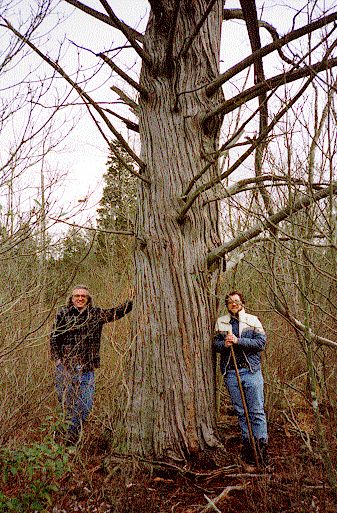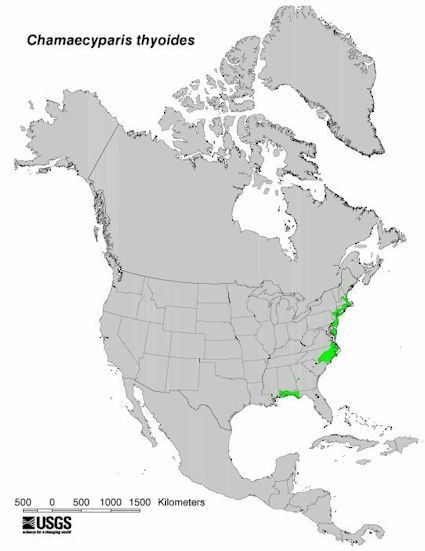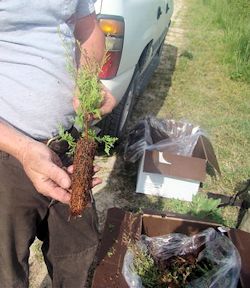Bringing Back the Juniper
By Catherine Kozak

That’s John Kuser of Rutgers University, left, and George Zimmerman of Richard Stockton College of New Jersey standing next to the New Jersey record Atlantic white cedar. The tree grows near Nixon Branch in southern New Jersey. It’s 9 feet, 6 inches in circumference at breast height. This battered old tree, which may be 300 years old, grows not far inland from Delaware Bay and has lost its top at least once to hurricane winds. Photo: Rutgers University
Two property owners in Hyde County have agreed to participate in a new program that’s the result of a partnership of the N.C. Coastal Federation and the U.S Fish and Wildlife Service. It pays private landowners to plant cedar trees on their property. About 700 seedlings an acre, each 6 to 12 inches tall, will be planted later this year on the landowners’ 54 acres.
For Patrick Harrison, who owns four of those acres, it fits perfectly with his lifelong appreciation for juniper.
“It’s really hard to find decent juniper,” said Harrison, owner of Harrison Boatworks in Wanchese. “Even if I was not able to harvest these trees, I’d still be in the program just to watch them grow.”
Harrison’s respect for juniper began at a young age. Renowned for its resistance to rot and insects, cedar also is bendable and has a straight grain. His father used to have a business in Columbia selling red cedar and white cedar at good prices.
“A lot of people were able to put juniper into their houses and cottages because of that little business,” he said.
His fondness for the wood is also revealed in the title of his blog, “Juniper Dust,” and the name he gave his wirehaired pointing griffon dog, “Juniper Jeke.” Not to mention that a big barn on his land is sided with juniper.
As a boatbuilder, Harrison uses juniper in his boats’ cores, that is, the parts that define the lines of the boat. The wood “takes a pretty good bend,” he says, is lightweight and it “takes a screw nicely without splitting.”
Few woods can compare, he said, although Spanish cedar from Central and South America is even more impervious to rot but costs three to four times more.
Harrison plans to plant about 2,800 trees on four acres of his 20 acres of property near Engelhard. He acquired the land in a trade with Earl Pugh Jr., who offered the land in exchange for a boat Harrison built for him. The property borders 400 acres of farmland owned by a close friend.
Harrison said he is in the process of clearing 20-foot wax myrtle trees off the property in preparation for the planting, which will be done by the U.S. Forest Service. The shallow-rooted myrtle trees, which were nearing the end of their lives, will be snatched up and piled in rows on the land and allowed to rot.
The 50-acre parcel also in the program is owned by Wysocking Wildlife Sanctuary, near Engelhard. Established by Dr. Karl Busbee Pace, who died on June 28 at age 90, the non-profit organization is dedicated to the preservation of habitat for wildlife.

Ladd Bayliss
Bayliss said that the landowners are in charge of getting the contracts lined up and for getting the work done. They will be reimbursed for 80 percent of the cost by the U.S. Fish and Wildlife Service.
“It does take a lot of landowner initiative to keep the project rolling,” she said.
The federation is hoping to get help from sixth- to eighth-grade students at Pungo Christian Academy in Hyde County, she said. The young people will learn a hands-on lesson about preservation and ecological balance, as well as help reduce costs.
The partnership to restore Atlantic white cedar in the Albemarle-Pamlico ecosystem is a part of an ongoing regional effort by the Wildlife Service. At the Great Dismal Swamp, for instance, hurricane-damaged trees had been removed in order to allow sunlight to germinate cedar seeds in the organic soil.
The largest area of cedar swamps are in Eastern North Carolina, southeastern New Jersey and northwestern Florida. When the European settlers first arrived, there were close to 500,000 acres of Atlantic white cedar along the Atlantic coast – probably half of it in North Carolina. In 1995, biologists estimated that only five percent of that total remains.

Atlantic white-cedar grows in a narrow coastal belt 50 to 130 miles wide from southern Maine to northern Florida and west to southern Mississippi. Map: U.S. Geological Service
But the population did not bounce back well from the massive logging that took place from the late 1800s through the 1960s.
“The species is one that does not regenerate well naturally,” he said. “That is the reason that the forests that were here a century ago are gone.”
Cedar’s companions in the forest – maple, gum trees, bay – grow faster, and can crowd out cedar in the competition for sun. At places in Tyrrell and Dare counties, cedar will grow together in thick stands, Smith said, “almost like a monoculture.”
Atlantic white cedar will tolerate flooded conditions, but only for a short duration.
The trees have reached as high as 120 feet and 60 inches diameter in North Carolina, and between 40- to 90-feet in other locations. Some Atlantic white cedars are reportedly 1,000 years old, but most stands are no older than 200 years.
White cedar stands are highly valued by ecologists because they provide food and cover for a large number of migratory birds. They also improve water quality, control erosion and reduce concentrations of mercury and nitrogen in the soil.
Smith said that cedar forests are vulnerable to peat fires, where the soil itself is actually burning – as it did in the Pains Bay near Stumpy Point in 2011.
“A deep peat fire will consume the food source – the seeds –for the Atlantic white cedar,” he said. “It’s going to kill the trees.”
Deer also present a challenge to survival of seedlings. Smith said that most strategies to discourage deer are expensive and impractical. The most reasonable solution seems to be planting extra heavy.

About 700 juniper seedlings like these will be planted on each acre. Photo: U.S. Fish and Wildlife Service
Motivation is different for each participant, Smith said. Some landowners want the trees to benefit the habitat or fulfilling a conservation ethic. For others, it may be the idea of having a forest product in the future.
Although this is the first time the agency has partnered with the federation in white cedar restoration, he said, it has done similar projects elsewhere and hopes to continue the partnership with the federation in future restoration efforts.
“The landowners we’ve worked with are typically more conservation-oriented and they’re interested in wildlife,” Smith said.
Harrison, 43, said that he feels good that his land is being used to help the survival of juniper trees for future generations.
“By the time they’re mature, I won’t be able to use them,” he said. “My kids will be able to use them.”
ABOUT THE AUTHOR: Catherine Kozak
Catherine Kozak has been a reporter and writer on the Outer Banks since 1995. She worked for 15 years for “The Virginian Pilot.” Born and raised in the suburbs outside New York City, Catherine earned her journalism degree from the State University of New York at New Paltz. During her career, she has written about dozens of environmental issues, including oil and gas exploration, wildlife habitat protection, sea level rise, wind energy production, shoreline erosion and beach nourishment. She lives in Nags Head.